![]()
When I was a child my mother bribed me to read books. I believe the going rate was about dollar a book. Unemployed and still living with my parents (I was only 8 or 9 years old at the time), I did my best to earn a steady income by reading. Visits to the library and the added bonus of “pan pizza” deals from Pizza Hut kept me fueled. I got hooked on reading.
I was an addicted reader in high school and college, and reading remains one of my most active and regular habits.
According to my records, I’ve read over 760 books, and, if I follow through on reading regularly, I have no doubt I’ll hit my 2000 book reading challenge in the next 20 to 25 years.
As a bit of an “OCD” documentarist and hardcore reader, I’ve been reading and tracking the books I’ve read for sometime. I remember using an early service on Facebook via Living Social to log the books I read. I eventually switched to Goodreads as my primary means to track my reading, though I also have lists in Evernote and spreadsheets to help organize my reading.
While I shun most social media and rarely use Facebook or Twitter, I track my reading and share it on Goodreads. It’s ironic that I don’t often post an update status on my life, but there is a public url showing what I have recently read or am currently reading.
To me, it feels pretty profound and meaningful to hide from social networks but to make public what you read.
There a lot of ways to read book today from your tablet or phone to ereader or even a physical book. Unfortunately, in spite of all of the tech to read, the experience of tracking what you read is not quite as easy. At present there is no perfect solution for seamlessly tracking the books you read from your ereader.
In this post, we will look at tracking the books you read. We will briefly look tech challenges to seamless tracking of what you read. Then we will see some approaches to manual tracking using a spreadsheet or using a service like Goodreads. With this data, we can dig into the key data points about reading, including our reading trends and tracking a positive habit or goal like books read.
Finally we will conclude with a reflection on the intimacy of knowing what someone reads and sharing this publicly. For example, I’d argue that knowing what books someone reads might be more revealing that all of the garbage someone shares on Facebook.
How to Track: Tech Challenges in Tracking Your Reading
There are a lot of ways to read today. Whether you buy them at a bookstore or borrow them from a local library, many books are still read in their physical form. Increasingly many readers (myself included) use ereaders to consume their favorite novel or nonfiction tale.
The Kindle really was a revolution in reading. It made it easy to get nearly any book you want delivered to you over the internet in a few clicks. The buying, accessing and reading experience became almost seamless.
I take my reading seriously. I basically always have a way to read. I read mostly on my Kindle, though I have my fair share of physical books too. If I’m at home, I read with my eyes, but when I’m traveling, on the road or even running, I read with my ears using Audible. Audible is an Amazon service that makes it nearly seamless to listen to audio books.
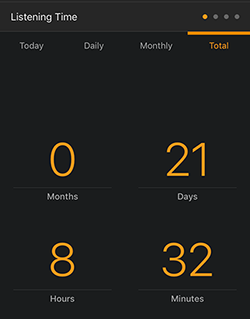
My Audible Subscription provides a steady stream of content, and the audible app provides quite a lot of data on my reading behavior. I can easily figure out exactly what books I’ve listened to and my total listening time. There are even segmented listening stats over time and achievement badges. This is one of the seamless forms of content consumption and tracking today.
But when it comes to tracking the books you read via your e-reader, there is currently no seamless technical solution for logging what you are reading and when you read them. We live in the age of ereaders like Amazon’s Kindle, which are great tools for accessing all kinds of reading material. Unfortunately you can’t get the same level of statistics with Kindle reading as you do with Audible.
It might be some technical challenges on why Amazon doesn’t provide user access to backend statistics or it might be a future feature. Your kindle is logging a lot of things, though you don’t have direct access to all of it.
In spite of a lot of personal digging and looking at Kindle’s logs, I found no good way to track how much I read on my Kindle, excluding a hack-ish solution using Kindle FreeTime. Essentially you setup a kid’s profile in FreeTime on your Kindle and you are able to set goals of pages read. From there you can see if you hit your daily goal and how many pages you read. It’s a clever workaround solution, and I did use this earlier this year to track my Chinese language reading over a period. But it’s not a perfect or complete tracking method.
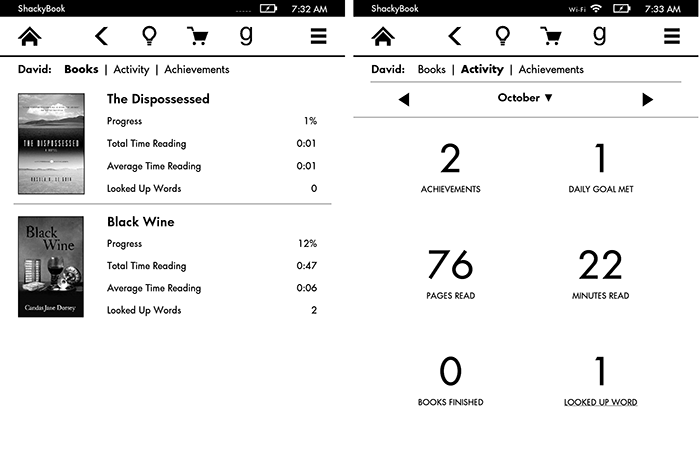
Book-by-book, Kindle does do a great job of providing how many pages and how much time left in your book or chapter. And considering you’ve marked and Kindle tracks where you are in every piece of content you are reading on a device, it’s feasible to generate stats on your reading from what’s on the device. From looking at the debugging logs, your Kindle could easily provide a history of your reading time too, based on powering on and off the device and accessing or closing different items.
So the data is there for a very reach form of tracking. It’s just locked into your device or in Amazon’s servers. You can’t simply sync your reading progress to the cloud and see all of your reading statistics and progress in one place. There is no ultimate “total pages” read for your Kindle you can access.
Book tracking solutions today require you to manually log what you read and your current reading progress. In spite of these barriers, as a self-tracker, there are quite a few good options to track your reading.
Options to Tracking Your Book Reading
As we’ve seen there is no seamless tech solution for logging your book reading, excluding through an audiobook listening service like Kindle. In spite of this lack of a passive tracking solution, it’s not hard to manually track what you read:
-
Highlight What You Read: If you use a kindle or another ereader, then I highly recommend that you use the highlighting function. This lets you mark key sentences and take notes too. Helps your memory and gives you a good record for later on your books.
-
Keep a Physical Reading Journal: This is a physical notebook you write in as you read or after you finish a book. There are even several commercial reading journal options. By keeping a journal you can note the ideas you found important and record your favorite quotes.
-
Keep a Digital Reading Journal: I take notes on most of what I read, and using Evernote, I’m able to look back later on books I’ve read and the key passages I’ve highlighted.
-
Export and Re-Read Your Highlighted Passages: These highlighted sections can be easily exported using a tool like Calibre. Clippings.io is a great tool for parsing your clippings and can help you export them into Evernote or a simple text file. While you can’t track your overall reading on Kindle, you can leverage your highlights and notes to reveal some of your reading patterns.
-
Record Your Reading in a Spreadsheet: A lot of tracking can be done with a spreadsheet and tracking your reading is no different. Simply record the title, author and other key info you want about books you’ve read. I find it useful to note when you started and finished a book as well as to note the book’s genre and publication date. This makes for interesting charts when you compare.
-
Using an Online Reading Logger and Tracker like Goodreads: There are a number of services online to log the books you read. The biggest and my preferred is Goodreads. It’s easy to add and the data you get back makes it possible to track what you read when and how much you read over a period, which we will look at more in the next section.
Considering most normal readers are only reading 20-30 books per year and heavier readers might read 100 or more, it’s reasonable to do your book reading tracking manually. The key thing is to note when you started a book and when you finished it.
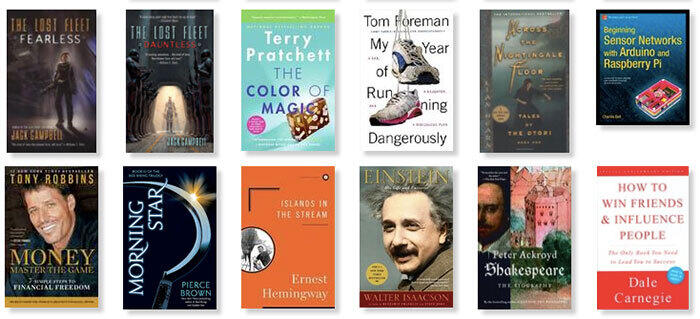
Goodreads: Tracking Your Books on the Web’s Largest Platform for Readers
Goodreads is how I currently track my reading.
After a long stint as an independent service that grew into the largest social platform for readers and their books, Goodreads was acquired by Amazon. In spite of that change, it still feels like a community platform for and by readers, including myself. It is also popular for many writers too.
Goodreads is a service that, according to its website, “lets users track and rate books and network with other readers.” It’s basically a reading tracker/logger and a social network about books, readers and writers.
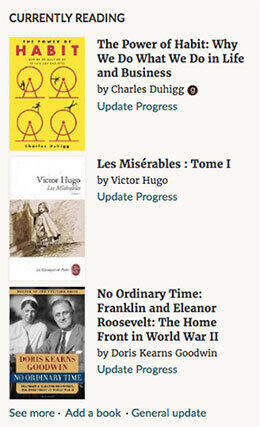
How does it work? You first search for any book in the Goodreads database and add it to your reading list. From there you can track your progress in pages or percentage as you read. Once you’ve finished a book, Goodreads does a good job of adding it to your “books read” list and providing a range of statistics and visuals. It’s a web-based tool primarily but has great apps on iOS and Android.
Functionally Goodreads is a service to track books you have read, will read or are currently reading. Beyond that, it’s a social network of sorts, a social network about books, for readers and involving writers. If you’ve added friends or favorite authors on Goodreads then you’ll be able to see their reading progress too. It’s a community.
The primary way the community interacts with books is through book reviews and ratings. When you finish a book and go to log it into Goodreads, the service quietly prods you into leaving a rating and up-sells you on writing a review. These ratings and reviews are the major data point collected from its users. It’s a powerful way to see what things people like and don’t. I sometimes use it as a way to check if a book or author is worth reading and enjoy seeing my friend’ ratings.
As a self-tracker, I’m careful about what tools I take on. In particular, I’m worried about great tools that make it hard to get my data. It’s not worth tracking with a tool if you can’t get your data. Goodreads provides a lot of data back about your reading but most importantly it has a great and detailed export about all of your logged book.
At least at the time of writing, you can get your export by going to “My Books” and clicking “Import/Export.” The export Goodreads provides is extremely detailed and useful for spreadsheet analysis.
Let’s look at the data.
Key Data Points for Self-Trackers: Total Books and Pages Read
While there are a lot of areas where you can passively track in the background like tracking your computer time, music listening, movements, or location, there are quite a few areas you need to log manually. We often categorize these as forms of “life logging” wherein you write down, click, push a button or do some other effort to log something.
Some areas like task management are basically productivity tools that come with the added bonus of statistics. Some examples of manual tracking including tracking your food, the movies and TV shows you watch and the habits you do. Each of these areas of tracking provide aggregated data and overall stats to look at it. Book reading falls into this the category of manual tracking.
We’ve looked at using Goodreads in detail, but much of the same benefit could be gained through a simple spreadsheet. With this tracking data, there are a few obvious data points to follow up with. The most obvious is your total books read and books read over a period in time.
Goodreads makes it easy to get your total books read count since essentially all of your books are on different “digital” bookshelves. These lists, including past read and currently reading make it easy to see your totals.

Goodreads allows you to create your own custom bookshelves too. So, it would be easy to create your own simple tracker by logging books read into your own special book shelf for fantasy, historical nonfiction, etc.
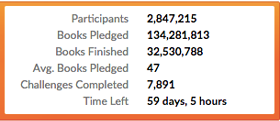
One of the other great social interactions and habit building innovations Goodreads incorporated is its Reading Challenge. Each year Goodreads let’s you commit to how many books you want to read that year and then as you log books read, you advance on your goal. I’ve found it a fun way to improve my reading and push my friends and family to read more. You can find my 2016 Reading Challenge here.
Essentially the Reading Challenge represents a commitment on your yearly total of books read. Goodreads also provides a full stats area of books read by year.

Total books read and books read by year are great number to use as you pursue your reading objectives. But if you want to think on a more daily or weekly level, you are likely going to need a different number to track. For me this is total pages read.
Even though there is no seamless tech on Kindle and most other e-readers to track your pages read, “pages read” is a useful statistic you can pull from your Goodreads profile. You can find it on your Stats Page:
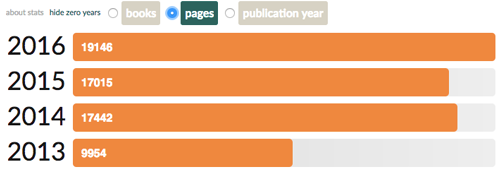
From what I can tell this number is a calculation of books read and the pages in that book. This number might not be entirely accurate since it only calculates completed books and excludes partially read books.
I do weekly reviews and consider reading time to be an important part of understanding my overall well-being. Too much reading might indicate an imbalance as would a week of low reading. I look at this “pages read” as a “ballpark” measure to gauge how much reading I did in a week. It’s can be an interesting correlation with my tracking of TV and Movie Watching in the same week.
Key Data Point: What Types of Books, Authors Am I Reading?
How many pages and how many books you read are fairly boring statistical measures about books and your relationship to them. These data points are useful when you think about your productivity, energy and work/life balance. But they aren’t that meaningful about our deeper ties to books.
What’s more interesting and meaningful is looking at your tendencies as a reader. What types of books are you reading? What genres? What authors? Mostly men? How many women? More recent books or older classics? What about language and nationality?
For me these questions are the more interesting aspects you can look at when it comes to reading tracking. By having a log of the books you read, you can start to see trends. Once you know these trends and biases, you can start to make some choices about broadening your reading horizons too. It can help you guide exactly what you read.
Beyond what books, how many and how pages, Goodreads does not provide additional graphs about your reading tendencies. I’d say this is Goodreads biggest weakness when it comes to the data you are sharing about what you read. For example, it should be easy to see a breakdown of the genres you read most.
Goodreads and Amazon do provide a powerful and interesting recommendations engine. By looking at your bookshelves, it can provide lots of good books you might like based on your reading history.
Since Goodreads provides a complete export of your reading history and reviews, it’s easy to pull this data into your preferred spreadsheet and start your analysis. I’ve started using this to gain more transparency on the genre, authors and time periods I’m reading and hope to share more on this too. Here is an interesting article on this approach using spreadsheets for tracking and analyzing your reading.

Fortunately, there is a cool open source project called “GR Stats” that can pull your Goodreads Reading Data to generate some interesting graphs and insights about your reading behavior. You can checkout the live version at https://victor.shinyapps.io/gr-stats/ or view the code on Github.
I’ve included a screenshot of what “my pages per day” looks like. (Confession: I rarely log my reading status every day, so there are some logged days with big numbers).
Unfortunately GR Stats doesn’t provide a breakdown by Genre. Goodreads itself doesn’t store an official genre listing on book, so it’s an understandable gaps. Genres in Goodreads come from the community and the bookshelves people place content on. Personally if I want to get more stats on genre reading, I either need to start noting the genre via Goodreads bookshelves or noting it in the spreadsheet I also use. Hopefully I can share an update on this in my yearly review.
One pertinent question I had about the books I read was the breakdown of male vs. female writers. I knew I read mostly men, but I wasn’t sure the breakdown. GR Stats made this obvious:
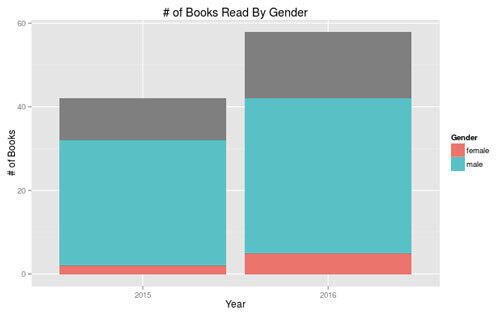
Even though I have increased my overall number of female writers this year, I clearly don’t read many females. This is an area I hope to improve upon as well as trying to expand my reading into more international writers and minorities.
Overall, by tracking your books you have a record that you can dig into on all kinds of questions like male vs female writer, publication year of books, and much, much more. I might go so far as to argue that what you read and consume (or not read and consume) could be the most telling data point we have about ourselves.
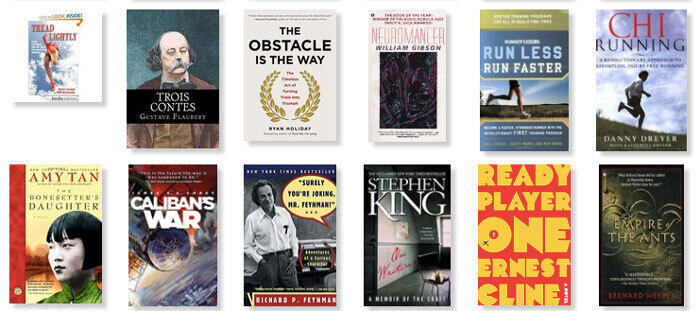
Conclusion: What We Read: Our Most Intimate Data Point
I don’t use Facebook, Twitter or other social much. But I do read and I share what I read publicly. I track my reading and it’s public data.
The books someone reads can tell a lot about who they are. Whether you spend your free time reading historical nonfiction, romance novels or self-help books, these choices reveal a lot about the internal mental life of someone. In aggregate form, they reveal a lot about society too.
Personally each year I base part of my choices about books to read on what was most popular, reviewed and important from the year before. Goodreads again is of great service via their Most Popular Books Published in each year. Checkout 2016.
Today we have social networks where people post and share dozens of types of information. From photos and articles to status updates and event participations, Facebook has a detailed record on us. Twitter acts like a gateway to stream of conscious insights and the latest news. There are dozens of small and large social networks that take different slices of what people share and create an online community.
That said, I find that a service like Goodreads might just have an edge on Facebook, Twitter and other social networks in a few ways, especially in the realm of understanding the deeper parts of a person’s mental thought patterns.
![]()
Publicly sharing your past, present and future reads can be a more intimate data point than anything else on the web about you. What you read is part of your thinking and who you are. Because what you read says so much about your way of thinking, it’s amazing how publicly people share this.
Personally, I like to have a record of what I do. I’ll admit to being slightly obsessed recently with tracking my life. It’s an experiment in life hacking, but also a test of the human capacity to create a detailed, data-driven record of a self in time. I currently track and make public what I read (Goodreads), what I watch (Trakt.tv) and what music I listen to (Last.fm).
For me, there are two reasons why I self-track. The first is that I’m dedicated to self-improvement and I believe having this data makes me accountable and helps me getting better.
The second reason is about memory. By tracking my life in different ways, I gain tracks and traces in time that can help lead me back to my past. Using my personal data, I can interpret a lot about what I was thinking during any period in the past.
Books and articles I read are one of the best data points I have about what was on my mind during a period in the past. Like looking at my journals and writings, the media I consumed opens up the memories of my life, thoughts and considerations during that time. What we consume is not a perfect reflection of who we are, but it might be one of the most profound data points to our souls.
Good luck, happy reading and happy tracking.
